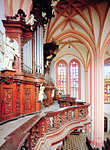SLAVKA SVERAKOVA
We did not stop in Litomysl, and hurried to OLOMOUC, the town where
Milan and I studied and met, and got married.
This is the dome
of St Wenceslas, just across from where I studied art history and
aesthetics for five years. This image allows me to imagine that the
western front looks directly at the library where I used to spent
long hours every day, the towers just being able to flirt with the
window behind which prof Markalous ( a writer, who did not wish to
live long enough for sosialism to succeed, because " it would be so
boring") and prof Trost supported by Rudolf Chadraba turned us from
rough greenhorns into somewhat more sophisticated thinkers about phjlosophy
and aesthetics in particular.
The dome lies at the edge of the ancient castle, at present, thoroughly
invisible.The castle Olomouc is mentioned in the prestigious Kosma
chronicle 1055. The original royal castle lied where my old seminar
was; there is still a small memorial to the last Premyslovec killed
in 1306.
Olomouc developed on and amongst five hills, well not really hills,
more a sudden swelling of the ground under your feet. You do mind
it if you carry several heavy books from the University Library to
your dormitory or to the seminar building. The last 300 metres it
is luckily downhill, only,at the right turn, to make you climb a really
steep 100 or so metres again.
The town developed around two squares, a slavonic village at St Morits
and long snake of the road passing under the ancient castles towards
the river Morava. It flows at the right angle to the long street,
which today ends at an enourmous T junction outside the modernist
train station. Arount it - the landscape is as flat as around S'Hertogenbosch
in Netherlands, or like the Norfolk Broads without the water.
The town was strongly protestant around 1500, but suffered forced
re - catholisation before the defeat of the Czech Protestants at Bila
Hora 1620. During the occupation by the Swedes (1642 -50) Olomouc
was completely devastated, all the population fled, the buildings
were destroyed. After 1742 the town was rebuilt as a baroque fortress
to protect Vienna against the Prussian Army. In 1876 the fortress
and fortification walls were destroyed.
The round tower (housing a chapel of St Anne) in the corner between
my old art historical seminar and the cathedral of St Wenceslas
are the survivor from the early medieval history, i.e. from the period
of romanesque royal palace in Olomouc. What we see today is a result
of activities around 1270, the vaults were added around 1350. The
choir, unexpectedly large and high, comes from 1616-18. On its northern
wall lies an ambit (1350), which utilised the Romanesque walls of
the royal palace from 1141. Some windows survived inside the building.
I looked again at the memorial to the last Premyslovec and to Mozart
on the wall of so called Hall of the Knights (where I gave a public
lecture in 1990; one university student was rather unhappy that "
you don't have a man in the centre of your system". "No - I answered,
I put water there.")
An Italian architect G.P.Tencalla rebuilt Church of St Michael - next
to the monastery, which in my youth was my six- form boarding
school, on gothic remnants. Below is St Moritz Church.

( subject of my
PhD thesis) - a special type of a hall with the crossvaults in the
nave and aisles at the same height. It has two individual towers;
the smaller northern one is dated 1412. The sculptures of the Getseman
Garden from a niche on the southern outer wall were this time missing.
Perhaps to protect them they were removed from the public access?
What an irony. Also - this time nobody played Bach's Toccata in D
on
the organ. The
image on the right is
The City Hall and the Column of St Trinity
in the middle of the main square. The city hall from 1378 was enlarged
in the 15th and 16th centuries and the tower with the clock was added.
We have not seen the Column of Saint Trinity, it was wrapped up in
scaffolding. And the six fountains - where were those?
The square was subjected to so much roadworks, blocks, no entries,
barriers etc. that its space was all but killed. No wonder - I escaped
to the river that two years ago flooded the city and the surrounding
villages. On the other side of the river Morava we saw the proud building
of Hradisko. Built by Tencalla in 1686 finished 1736.
It is on a site where there was a Slavonic settlement in 9thC, and
then 1078 Premyslovci founded Benedictine monastery, in 1150 it was
taken over by the Premonstrate Order. The monastery was abolished
in 1784 - the building served as military hospital.
The road to Hranice, Teplice and Roznov let us glance at Svaty Kopecek
above Olomouc, a monastery and baroque church. The countryside is
hilly and forested but in some way totally uneventful. It is a relief
therefore to glance at Radhost. We found the turn to the left from
the Middle Becva and drove up to Pustevny, a collective name for three
wooden buildings designed by Jurkovic, whose other buildings we would
see in Luhacovice Spa later.
Slavka Sverakova